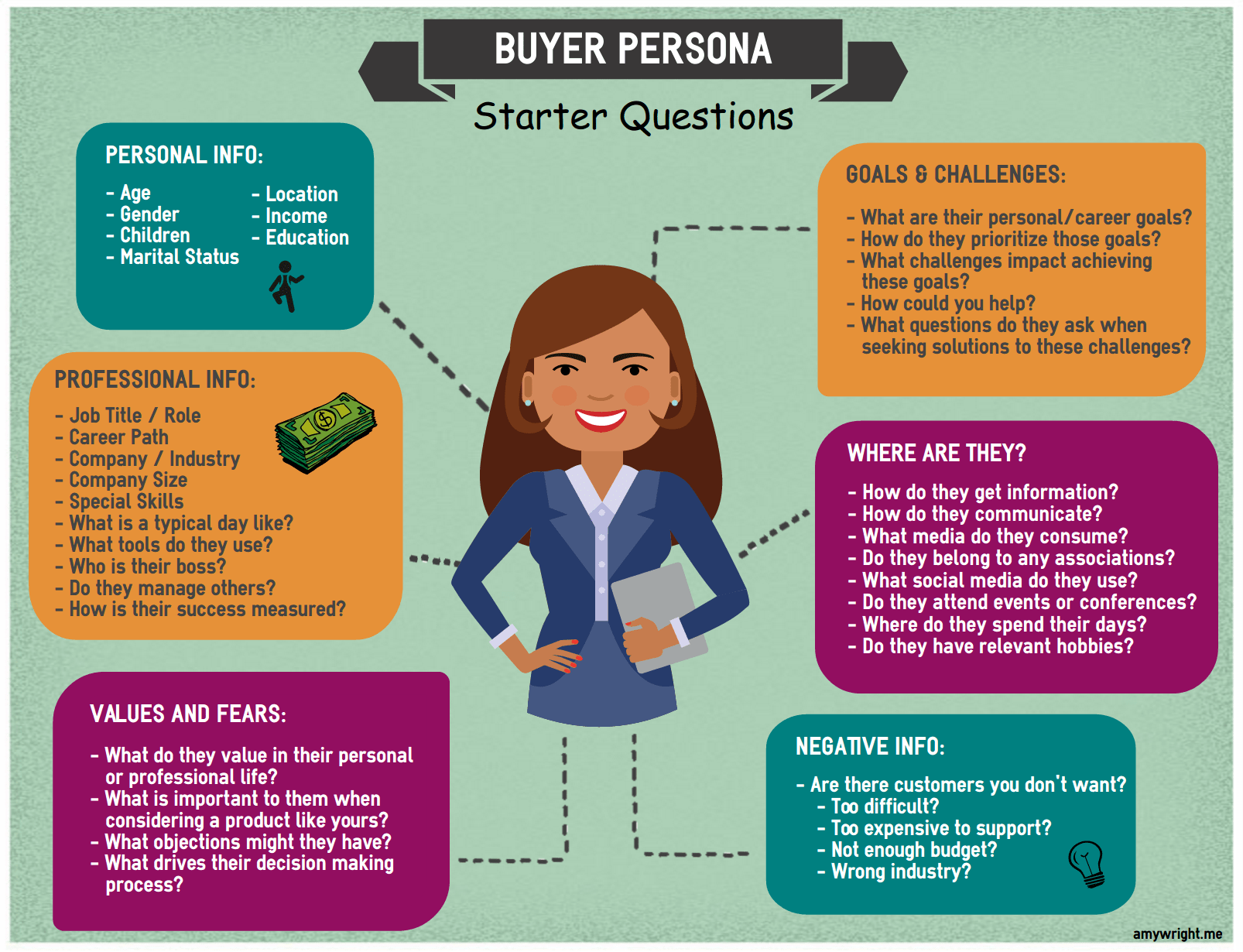
If you’ve been anywhere near the world of marketing in the last few years, you’ve probably heard the term “buyer persona.” It’s tossed out casually as if everyone has one, and everyone knows what it is.
But that’s simply not true.
If you found this article after a covert search for “What Is a Buyer Persona?” and you’re hoping to find out what the heck everyone’s talking about, you’ve come to the right place.
First, let’s get the definition out of the way.
What Is a Buyer Persona?
A buyer persona is a research-based profile that depicts a target customer. Buyer personas describe who your ideal customers are, what their days are like, the challenges they face, and how they make decisions.
It’s common to have multiple buyer personas for a business. For example, if the end-user of your product must gain the approval of others before making a purchase, each individual involved in that decision is a separate persona. They will have different criteria for evaluating your product, and you will need different strategies to address their needs.
Buyer personas are sometimes called customer or marketing personas (or profiles), but whichever term you use, the purpose is the same. Buyer personas help businesses understand and empathize with their customers so they can do a better job of acquiring and serving them.
Why Are Buyer Personas Important?
Buyer personas help ensure that all activities involved in attracting and serving your customers are tailored to their needs.
This may sound like a no-brainer, but it isn’t as simple as it sounds.

If you really pay attention to the way companies present themselves, you’ll begin to notice that many of them start by talking about what they do, not what the customer needs.
This puts them at odds with the way people make decisions.
When choosing a product or service, people naturally gravitate toward businesses they know and trust. And the best way to build trust is to show genuine understanding and concern for the other person – in this case, your customers.
Gaining trust as a business requires a subtle but important shift in how you present yourself. First, show your potential customers that you get them by addressing their pain or need. Only then will they be open to exploring what you have to offer.
Creating buyer personas and continually using them to guide your business can help keep you centered on the needs of your customers.
How Are Buyer Personas Used?
The very process of building a buyer persona is illuminating. To craft a persona, you must ask yourself in-depth questions about your ideal customers, and this exercise alone will help you notice things you hadn’t before.
You can then compare your answers with those of your colleagues. This will unearth inconsistencies in your perspectives and foster discussions to resolve them.
One of the immediate benefits of a buyer persona is that it helps you gain customer insights and cross-departmental alignment. This will ensure that marketing, sales, product development, and customer support all have the same view of your ideal customer.
You can then use your personas to guide the direction of your work. For instance:
Product development can use buyer personas when building product roadmaps. Personas help them identify and prioritize changes to your offering based on what your customers need the most.
Marketing can use buyer personas to build effective strategies. When creating content marketing strategies, for instance, personas are critical. They help to focus keyword research efforts and are used as reference when crafting copy. They can also help in the identification and prioritization of promotional activities.
Buyer personas can also help your sales team build rapport with potential customers. By understanding what the prospect is dealing with and coming prepared to address their concerns, your sales team will be much more effective.
And finally, customer support teams can use personas to serve your customers better. Your staff will be able to show more empathy if they understand the problems your customers are trying to solve with your product and the frustration they feel when things don’t work out. A little compassion can go a long way when dealing with an angry customer.
Should Very Small Businesses Bother Building Buyer Personas?

It’s pretty easy to see why buyer personas are important for businesses with multiple employees. But, if you’re a solopreneur or a very small business, you might still be wondering why you should bother. After all, you know who your customers are. Wouldn’t this be a big waste of time for you?
Well, no. It really wouldn’t. If you want something, it always helps to clearly define what you’re going after.
For example, let’s imagine you’re a self-employed personal trainer. You have a website and a blog where you share tips and tricks for staying fit. Obviously, you wish to attract customers who are interested in hiring a personal trainer. A buyer persona will help narrow your focus.
Perhaps you will find that the majority of your customers are new mothers in their 30s. Presuming this is a market you would like to continue serving, you can now adjust your website and blog content to target this specific niche. This will make it easier to write copy for your website and to select blog topics that will resonate with your target audience.
How Do I Create a Buyer Persona for My Business?
Buyer personas should incorporate a combination of internal and external research. And some businesses will need to create multiple personas to represent different types of customers. But you don’t have to do it all at once. It’s okay to start small and let your personas evolve over time.
Choose one target customer and build a persona based on what you already know, then create a plan to enhance it with more research.
The best way to start is to create a list of questions that you can use to interview members of your team. There is no one-size-fits-all list of questions, but here are some common ones that can help get you started.

After conducting your research, you’ll be ready to create your first buyer persona. Again, there isn’t just one way to approach this, but at least aim to build a one-page document or slide for each persona. That way, you can easily pull it up on your screen or print it out and use it for reference. If you would like some examples, HubSpot published an article titled “What Does a Great Buyer Persona Look Like?” which is quite helpful.
Once you have your first persona, you can work to enhance it by talking with customers and/or asking them to complete surveys. Buyer personas shouldn’t be static documents, but they don’t have to be a massive undertaking. They can evolve as you learn more about your customers, so be patient with this process and integrate new insights along the way.
Conclusion:
Buyer personas are research-based profiles that represent your target audience and can help you adapt key aspects of your sales and support for greater success. Clarifying the types of people who benefit from your solutions (and the challenges you help them solve) is critical to your efforts to attract and retain customers.
If you need help or would like to ask for more clarity, I would love to speak with you. Otherwise, have fun creating your buyer personas! I promise it will be worth the effort.




